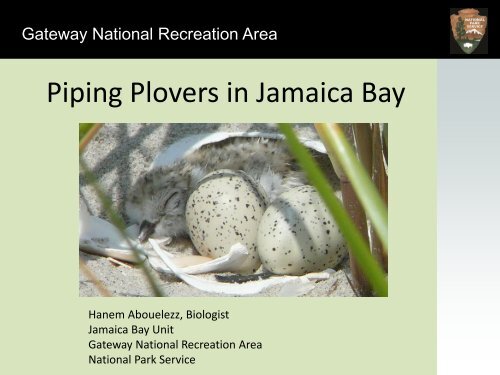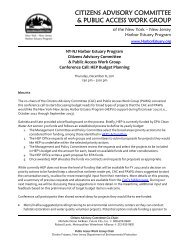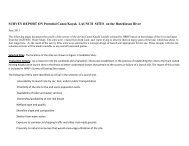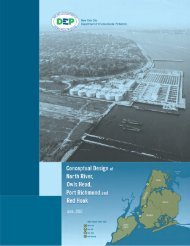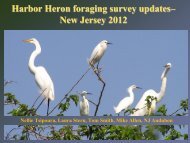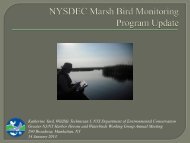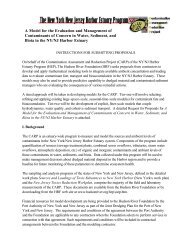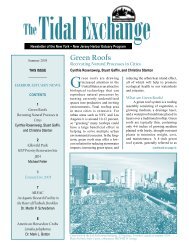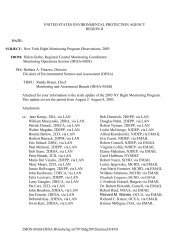Abouelezz_Piping Plovers 2013 .pdf - New York-New Jersey Harbor ...
Abouelezz_Piping Plovers 2013 .pdf - New York-New Jersey Harbor ...
Abouelezz_Piping Plovers 2013 .pdf - New York-New Jersey Harbor ...
- No tags were found...
Create successful ePaper yourself
Turn your PDF publications into a flip-book with our unique Google optimized e-Paper software.
Gateway National Recreation Area<strong>Piping</strong> <strong>Plovers</strong> in Jamaica BayHanem <strong>Abouelezz</strong>, BiologistJamaica Bay UnitGateway National Recreation AreaNational Park Service
Gateway National Recreation Area
Gateway National Recreation AreaThreatened and Endangered Species“Our mission is to reduce the risk ofextinction of plants and animals in the parks,and to restore species that have occurred inparks historically but have been lost tohuman activities.”FrankDesisto.com J. Portmann NPS
Gateway National Recreation AreaSpecies Status• Atlantic Coast population of the piping plover (Charadrius melodus)listed federally threatened January 1986• Threats to the population include: habitat loss and degradation,predation, human disturbance, wind turbine development andclimate change (USFWS 2009)• Minimum subpopulation for <strong>New</strong> <strong>York</strong>-<strong>New</strong> <strong>Jersey</strong> recovery unit = 575pairs for 5 years [586 pairs in 2008] (USFWS 2009)• GNRA, in consultation with USFWS, implemented a piping plovermanagement plan in 1989
Gateway National Recreation AreaManagement Area• Nesting habitat: above high tide line on coastal beaches, sand flats,foredunes, washovers areas between dunes. Areas characterizedby no or sparse vegetation• Foraging habitat: intertidal zones, washover areas, sand flats andshorelines• Gateway manages Rockaway beaches for breeding piping plovers.Beaches include: Jacob Riis, Ft. Tilden, Silver Gull Club, WestBeach, Breezy Point Tip
Gateway National Recreation Area
Gateway National Recreation AreaMethods• <strong>Plovers</strong> arrive in early March• Traditional breeding areas are enclosed by symbolic fencing by midMarch• Biological monitoring begins in mid-April and concludes in late JulySeasonal employees andvolunteer interns• Nests located via monitoring of ploverbehavior and are enclosed withpredator enclosures
Gateway National Recreation AreaMethodsNPS Fire Island
Gateway National Recreation AreaMonitoring ResultsNests discovered between April 17 th and June 29 th. Nesting occurredon Breezy Point tip, West Beach and the Silver Gull Club beach.Pairs = 18Eggs = 92Chicks hatched = 30Hatch Rate = 33%Fledges = 17(up 6.25% from 2011)Fledge Rate = 57%Productivity (Fledges/Pairs) = 94%
Gateway National Recreation AreaMonitoring ResultsYeah, yeah, yeah…How do those numbers match up?
Gateway National Recreation AreaTrends
Gateway National Recreation Area
Gateway National Recreation Area
Gateway National Recreation Area
Gateway National Recreation Area
Gateway National Recreation Area
Gateway National Recreation Area
Gateway National Recreation AreaTrendsThe good:- # pairs above average- # eggs produced well above average- good fledge rateThe bad:- hatch rate could use improvementThe bottom line:- Egg loss prior to hatching is the weak spot in the program- Improvement in this area could increase productivity
Gateway National Recreation AreaDisturbance & Violations• Predators feral cats, raccoons, dogs• Interspecific Competition American oystercatcher (Haematopuspalliatus)- Terns CoOp = increased oystercatcher co-occurrence withnesting plovers• Humans jogging, fires, pets, motor vehicles, kite flying, swimming• Egg Theft Two nests vandalized, discovered July 4 th- Single hole ripped into the top of the exclosure- Egg collector? No resolution at the point• Other reasons for nest/egg loss tides and storms
Gateway National Recreation AreaBrave <strong>New</strong> World…Tony Luscombe 2012
Gateway National Recreation AreaBrave <strong>New</strong> World…• Hurricane Sandy removed vegetation and increased the availability ofsuitable nesting habitat for the piping plover as well as other specialstatus species (Common Terns, Least Terns and Black Skimmers)• “Will the number of nesting pairs and/or reproductive successincrease proportionally to this increase in habitat or will otherdisturbances hold back productivity?”- Using pre and post storm satellite imagery to quantify theamount of nesting habitat in ArcGIS• Will terns return to NPS property, thus buffering nesting pipingplovers from American oystercatcher harassment?• <strong>2013</strong> should be a interesting season!
Gateway National Recreation Area?Any Questions?Thanks to Tony Luscombe, Jessica Browning, Doug Adamo, Dave Avrin, GeorgeFrame & 2012 Jamaica Bay Unit Seasonal Biological Technicians and Interns


